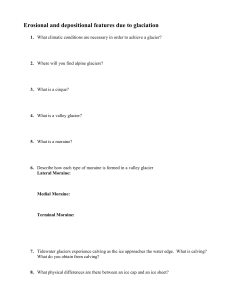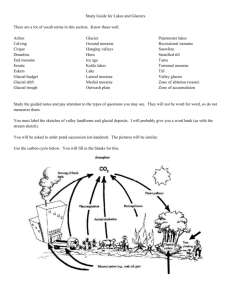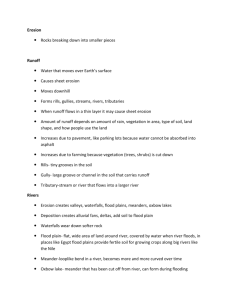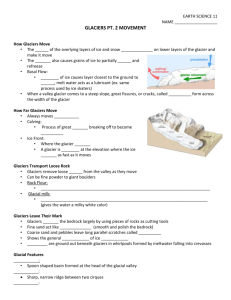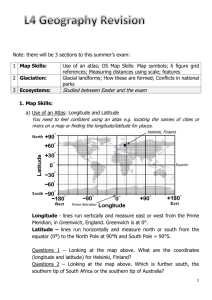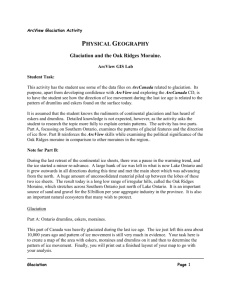Model Answer for 2000 Lithosphere Question
advertisement
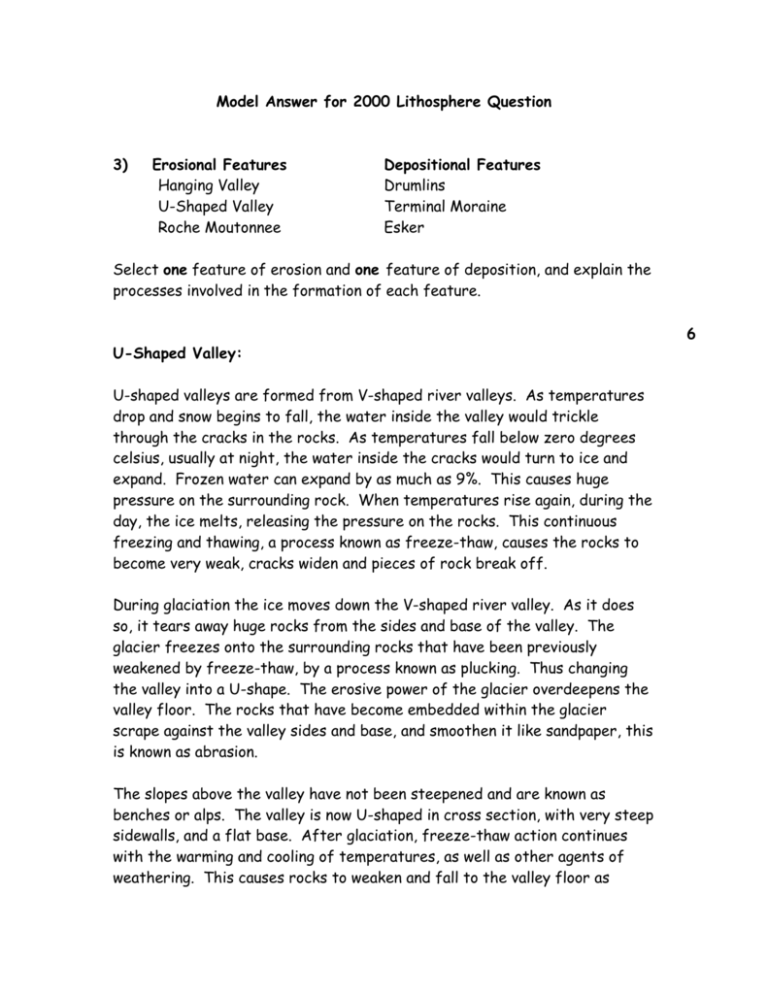
Model Answer for 2000 Lithosphere Question 3) Erosional Features Hanging Valley U-Shaped Valley Roche Moutonnee Depositional Features Drumlins Terminal Moraine Esker Select one feature of erosion and one feature of deposition, and explain the processes involved in the formation of each feature. U-Shaped Valley: U-shaped valleys are formed from V-shaped river valleys. As temperatures drop and snow begins to fall, the water inside the valley would trickle through the cracks in the rocks. As temperatures fall below zero degrees celsius, usually at night, the water inside the cracks would turn to ice and expand. Frozen water can expand by as much as 9%. This causes huge pressure on the surrounding rock. When temperatures rise again, during the day, the ice melts, releasing the pressure on the rocks. This continuous freezing and thawing, a process known as freeze-thaw, causes the rocks to become very weak, cracks widen and pieces of rock break off. During glaciation the ice moves down the V-shaped river valley. As it does so, it tears away huge rocks from the sides and base of the valley. The glacier freezes onto the surrounding rocks that have been previously weakened by freeze-thaw, by a process known as plucking. Thus changing the valley into a U-shape. The erosive power of the glacier overdeepens the valley floor. The rocks that have become embedded within the glacier scrape against the valley sides and base, and smoothen it like sandpaper, this is known as abrasion. The slopes above the valley have not been steepened and are known as benches or alps. The valley is now U-shaped in cross section, with very steep sidewalls, and a flat base. After glaciation, freeze-thaw action continues with the warming and cooling of temperatures, as well as other agents of weathering. This causes rocks to weaken and fall to the valley floor as 6 scree. The original river channel has altered and so when rivers take over after glaciation, they meander across the enlarged valley floor. These are known as mis-fit streams. Before Glaciation During Glaciation During Glaciation After Glaciation Roche Moutonnee: A roche moutonnee is a mass of resistant rock over which ice passed during glaciation. Before glaciation, this was merely a mass of hard, resistant rock. During glaciation, a glacier moved upvalley and slowly moved over this mound of rock. The stones and rocks that are embedded in the base of the glacier, known as ground moraine, scraped the rock on its upvalley slope, this smoothed the surface of the resistant rock as the glacial moraine scratched the surface like sandpaper. this process is more commonly known as abrasion. Often scratch marks known as striations are left on the mass of hard rock indicating that ice once passed over it. As the glacier moved over the mound of rock, it tears away rocks from the mound. This is known as plucking and it occurs when the glacier freezes onto the rocks and tears them away when it moves downhill due to gravity. Plucking is done easily on the downvalley slope because the rocks have been weakened previously by freeze-thaw action. This is where water enters cracks in the rock. When temperatures fall below freezing the water expands and turns to ice. Frozen water can expand by as much as 9% and therefore exerts huge amounts of pressure on the surrounding rocks. As temperatures rise the ice melts and releases the pressure. This continuous freezing and thawing causes the surrounding rocks to become very weak, and therefore can be easily plucked away by the glacier. As a result of this the downvalley slope is much steeper than the upvalley side. A roche moutonnee therefore has a smooth, gentle slope facing upvalley and a steep, jagged slope facing downvalley. Drumlins: Drumlins are hummocky deposits of boulder clay and till. They are oval shaped and are between 100 – 800m in length and between 25 and 100m high. One end of the drumlin is quite steep, known as the stoss end, while the other end, known as the lee slope, is longer and more gently sloping. The stoss end faces upvalley and it is this end that would have faced the ice flow. Drumlins were formed by the depositing of moraine from a glacier when it became overloaded with sediment. When the strength of the glacier reduced, material was deposited. The glacier however must have still been moving as the shape of the drumlin suggests that it was subject to the process known as abrasion, which created it streamlined shape. Abrasion occurs because glaciers have many rocks and stones embedded within the base of the glacier, these rocks have been torn away from the surrounding land. The rocks are jagged and scrape against the moraine as it moves over it. This process is similar to sandpapering, where the rocks rub against each other and smoothen the surface. Often, this process leaves scratch marks in the rock called striations. It is common to find many drumlins grouped together, known as swarms. Terminal Moraine: Terminal moraines or end moraines as they are often referred to are ridges of unsorted material at the snout of the glacier. They mark the furthest point reached by the ice sheet or glacier. Terminal moraines form when the ice melts and deposits all the moraine it was transporting at the front of the glacier. Glaciers can transport huge amounts of material including rocks, stones and smaller particles, it takes huge force for a glacier to be able to transport this material. Therefore, when it begins to lose its strength, for example when it begins to melt or retreat, it deposits some of this material. At this point the ice is still moving so material is constantly being added to the terminal moraine. The longer the ice continues to melt at the same place, the higher the terminal moraine. Glaciers carry moraine at the sides of the glacier, called lateral moraine, in the middle of the glacier called medial moraine, inside the ice, called englacial moraine and at the base of the ice called ground moraine. Therefore, terminal moraines are completely unsorted, and may extend for many kilometers. Esker: Eskers are long, narrow, sinuous ridges of stratified sand or gravel, which can be several miles long. The sand and gravel has been picked up and deposited by water, as eskers are generally regarded as features of fluvioglacial processes. Towards the end of the ice age, when glaciers and ice sheets began to melt, rivers and streams would flow inside and under glaciers in ice-walled tunnels. They are under great pressure from the melting ice and so are able to transport a lot of sediments. The sediment is deposited along the course of the sub-glacial river so that, when the ice melts and the meltwater drains away, the raised bed of the subglacial river is left as an esker. Eskers are layered because, at different times, the meltwater river would have differing amounts of energy and so deposits varying amounts of material of different size



